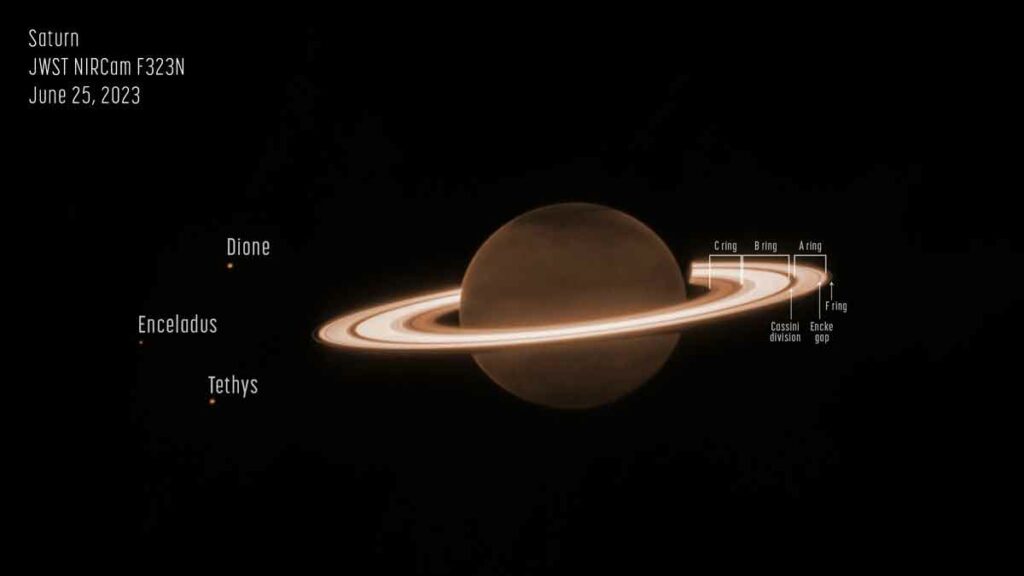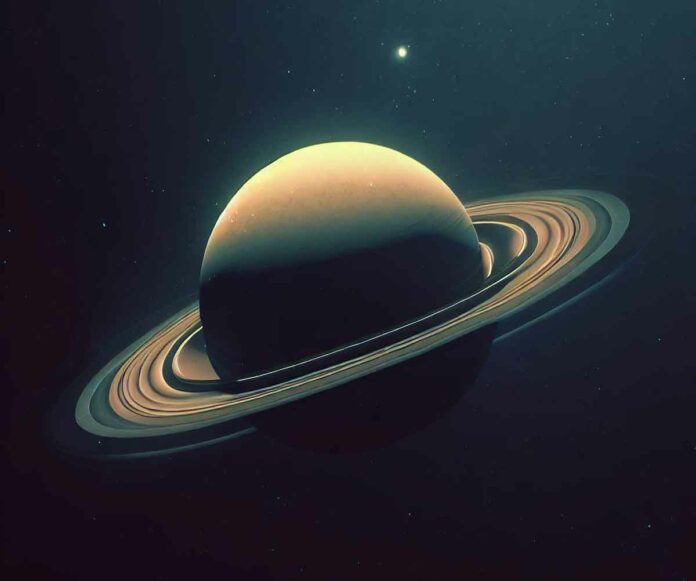Get ready to be amazed by the latest James Webb Space Telescope (JWST) image as it unveils the secrets hidden within Saturn’s celestial realm.
In this captivating infrared picture, Saturn’s iconic rings appear to glow eerily, while unexpected features in the planet’s atmosphere come to light.
The image captured by JWST serves as the backdrop for a groundbreaking observing program designed to test the telescope’s ability to detect faint moons encircling Saturn and its luminous rings.
The discovery of any new moons would provide invaluable insights to scientists, helping them piece together a more comprehensive understanding of Saturn’s present system and its intriguing past.
At the specific infrared wavelength of 3.23 microns, methane gas in Saturn’s atmosphere absorbs almost all the sunlight, rendering the planet’s familiar striped patterns invisible.
The upper atmosphere, rich in methane, obstructs our view of the primary clouds, resulting in a darkened appearance of Saturn’s disk.
Instead, the image reveals enigmatic high-altitude stratospheric aerosols in Saturn’s northern hemisphere, characterized by large, dark, and diffuse structures that deviate from the planet’s latitude lines.
Curiously, similar wave-like patterns were observed in early JWST NIRCam observations of Jupiter, adding to the allure of these newfound phenomena.
In stark contrast to the atmosphere, Saturn’s rings lack methane, causing them to appear as bright as ever at this infrared wavelength.
The new image captured by JWST showcases intricate details within the ring system, providing a captivating glimpse of several of Saturn’s moons, including Dione, Enceladus, and Tethys.

"We are very pleased to witness JWST producing this breathtaking image, which confirms the success of our scientific data collection efforts," expressed Dr. Matthew Tiscareno, a senior research scientist at the SETI Institute who led the observation design process. "We eagerly anticipate delving into the profound exposures to uncover the discoveries that lie ahead."
Over the past few decades, several missions, such as NASA’s Pioneer 11, Voyagers 1 and 2, the Cassini spacecraft, and the Hubble Space Telescope, have closely studied Saturn’s atmosphere and rings.
However, the image captured by JWST provides only a glimpse of the treasures this observatory will unearth about Saturn in the years to come.
Moving our focus from the inner to the outer features of Saturn’s rings, a mesmerizing panorama emerges.
We can observe the dark C ring, the bright B ring, the narrow and shadowy Cassini Division, and the medium-bright A ring with the dark Encke Gap near its outer edge.
Furthermore, at the outer edge of the A ring, the narrow strand known as the F ring comes into view.
The interplay of light and shadow between the rings and the planet creates visually captivating effects.
While this image does not showcase the fainter rings such as the thin G ring and the diffuse E ring, in-depth exposures conducted by JWST will enable scientists to investigate these lesser-known features.
Saturn’s rings consist of a medley of rocky and icy fragments, ranging in size from tiny grains of sand to mountains larger than those found on Earth.
Recently, researchers utilized JWST to explore Enceladus and made a remarkable discovery—a substantial plume emanating from the moon’s southern pole.
This plume contains particles and copious amounts of water vapor, contributing to Saturn’s E ring.
A closer examination of the image reveals typical seasonal changes between the northern and southern poles of Saturn.
The northern hemisphere is currently basking in summertime radiance, while the southern hemisphere slowly emerges from its winter darkness.
However, an intriguing anomaly catches the eye—the unusually dark appearance of the northern pole.
Scientists speculate that an unknown seasonal process might be affecting polar aerosols, causing this peculiar phenomenon.
Additionally, a faint brightening at the edge of Saturn’s disk hints at the possibility of high-altitude methane fluorescence or emission from the ionosphere’s Trihydrogen ion (H3+).
The precise analysis of these phenomena through spectroscopy by JWST could provide valuable insights and help confirm these theories.
In conclusion, the breathtaking infrared image captured by JWST has unveiled new facets of Saturn’s celestial splendor.
With its remarkable ability to delve into the mysteries of distant worlds, the observatory is poised to revolutionize our understanding of Saturn’s rings, moons, and atmospheric dynamics.
As scientists embark on this exciting journey of exploration, we eagerly await the remarkable discoveries that lie ahead, waiting to be unveiled by the awe-inspiring James Webb Space Telescope.
FAQs
The JWST image of Saturn holds great importance as it provides a captivating view of the planet’s rings and reveals unexpected features in its atmosphere. This image serves as a context for an observing program aimed at detecting faint moons around Saturn and understanding its current system as well as its past.
At the specific infrared wavelength of 3.23 microns used in the image, methane gas in Saturn’s atmosphere absorbs most of the sunlight, rendering the familiar striped patterns invisible. The methane-rich upper atmosphere blocks the view of the primary clouds, resulting in a darkened appearance of Saturn’s disk. However, Saturn’s rings lack methane, making them appear as bright as usual at this infrared wavelength.
The JWST image showcases intricate details within Saturn’s ring system, providing a glimpse of several of its moons, such as Dione, Enceladus, and Tethys. By studying these details, scientists can gain a better understanding of the composition, structure, and dynamics of Saturn’s rings and their interaction with the surrounding environment.
The JWST, with its advanced capabilities and technologies, is expected to revolutionize our understanding of Saturn. While previous missions like NASA’s Pioneer 11, Voyagers 1 and 2, the Cassini spacecraft, and the Hubble Space Telescope have provided valuable insights into Saturn’s atmosphere and rings, the JWST will delve deeper into the mysteries of the planet, uncovering new ring structures, identifying potential new moons, and providing unprecedented levels of detail.
Scientists conducting observations with the JWST hope to identify new ring structures and potentially discover new moons of Saturn. These discoveries would significantly contribute to our knowledge of the Saturnian system and enhance our understanding of the planet’s history, formation, and evolution.
The JWST image of Saturn allows scientists to observe the seasonal changes between the planet’s northern and southern poles. The dark appearance of the northern pole, possibly due to an unknown seasonal process affecting polar aerosols, raises intriguing questions about atmospheric dynamics. The faint brightening at the edge of Saturn’s disk also offers clues about high-altitude methane fluorescence or ionospheric emissions, which spectroscopy from the JWST can help investigate further.
The JWST’s remarkable capabilities and its ability to conduct in-depth exposures and spectroscopic analysis hold the promise of unveiling groundbreaking discoveries about Saturn. Scientists eagerly anticipate studying the planet’s fainter rings, investigating the composition and dynamics of its moons, and gaining deeper insights into the mysteries of Saturn’s celestial realm. The JWST is poised to revolutionize our understanding of this magnificent planet and its captivating features.

